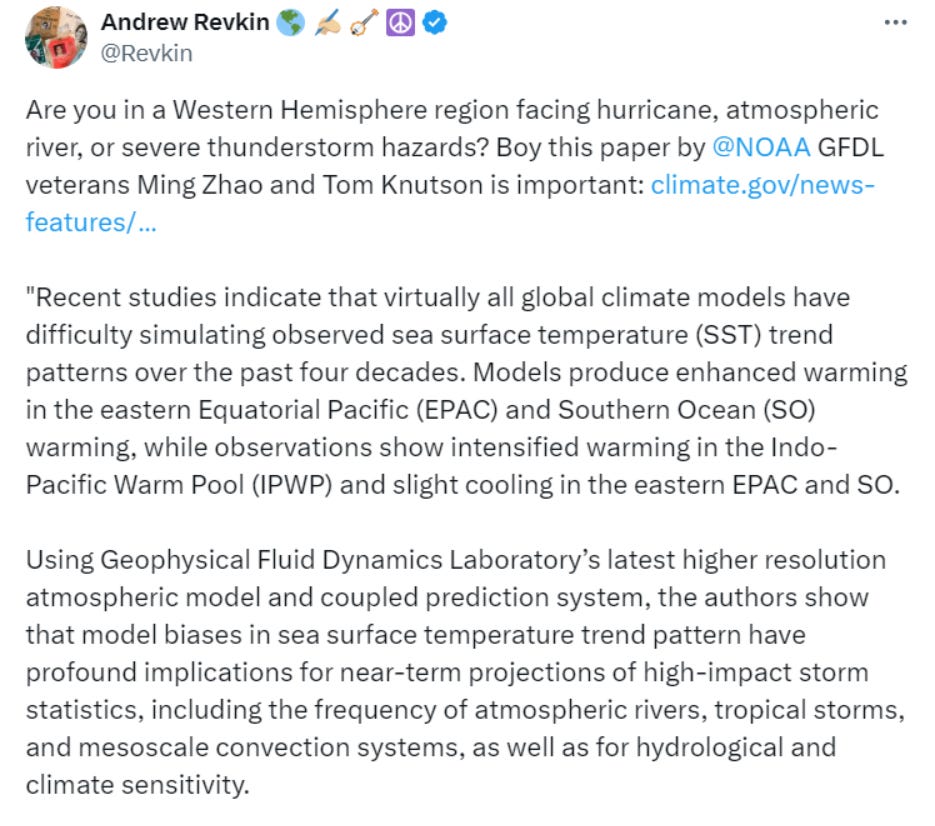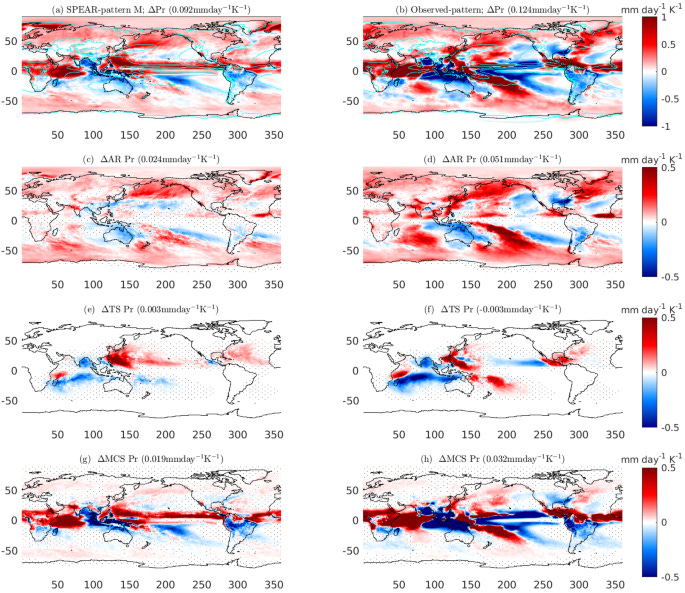Andy Revkin has alerted X users to an important paper which was published in Nature in June of this year, written by two veteran NOAA scientists. Thanks to Andy for posting it and Judith Curry for reposting it, otherwise it might have sunk without trace. Thanks to Elon for proving a platform where such ‘heretical’ science can be shared widely.
So, without further ado, let’s look at the actual paper and what it says:
Recent studies indicate that virtually all global climate models (GCMs) have had difficulty simulating sea surface temperature (SST) trend patterns over the past four decades. GCMs produce enhanced warming in the eastern Equatorial Pacific (EPAC) and Southern Ocean (SO) warming, while observations show intensified warming in the Indo-Pacific Warm Pool (IPWP) and slight cooling in the eastern EPAC and SO. Using Geophysical Fluid Dynamics Laboratory’s latest higher resolution atmospheric model and coupled prediction system, we show the model biases in SST trend pattern have profound implications for near-term projections of high-impact storm statistics, including the frequency of atmospheric rivers (AR), tropical storms (TS) and mesoscale convection systems (MCS), as well as for hydrological and climate sensitivity. If the future SST warming pattern continues to resemble the observed pattern from the past few decades rather than the GCM simulated/predicted patterns, our results suggest (1) a drastically different future projection of high-impact storms and their associated hydroclimate changes, especially over the Western Hemisphere, (2) a stronger global hydrological sensitivity, and (3) substantially less global warming due to stronger negative feedback and lower climate sensitivity. The roles of SST trend patterns over the EPAC, IPWP, SO, and the North Atlantic tropical cyclone Main Development Region (AMDR) are isolated, quantified, and used to understand the simulated differences. Specifically, SST trend patterns in the EPAC and AMDR are crucial for modeled differences in AR and MCS frequency, while those in the IPWP and AMDR are essential for differences in TS frequency over the North Atlantic.
It’s been known for years that climate models comprehensively fail to simulate the observed regional pattern in sea surface and subsurface temperature trends across the world’s ocean basins. I remember Bob Tisdale pointing this out repeatedly on Watts Up With That and elsewhere. This is the first time however, to my knowledge, that scientists have looked in detail at the implications of this failure. And the implications are pretty dramatic as it turns out. Not good news if you make a dishonest living out of selling climate and extreme weather alarm.
The authors summarize the problem more precisely:
Recent studies suggest that essentially all GCMs, including those with large ensemble (LE) simulations from varying initial conditions have had difficulty simulating the observed sea surface temperature (SST) trend patterns for the past few decades. In the historical simulations, GCMs generate intensified warming in the equatorial eastern Pacific along with Southern Ocean (SO) warming while the observations exhibit intensified warming in the Indo-Pacific Warm Pool (IPWP) and slight cooling in the eastern equatorial Pacific and Southern Ocean. The nature of such misrepresentation is still unclear and under debate.
The important thing to note is not just that the models are wrong, but that they are consistently wrong in the same way. This suggests that they all share the same fundamental error in the way that they simulate ocean warming - and as the oceans account for 75% of the globe’s surface area and more than 90% of the alleged ‘excess heat’ due to GHGs, then it’s fair to say that they fail to simulate the regional pattern of observed global warming. The authors say:
Figure 1a shows that except member 3 (members 11 and 26) all individual members of the SPEAR LE underestimate the trend of equatorial Pacific east-west (poleward) SST gradient, indicating that the model produces excessive equatorial eastern Pacific SST warming relative to the western Pacific and to the off-equatorial eastern Pacific. Choosing a narrower equatorial region such as 3∘S-3∘N makes the model bias even worse. The model’s biases in the east-west and poleward gradients are generally correlated among the SPEAR members and the observational estimates, indicating they may be originated from the same process. Figure 1b further shows that none of the individual members of SPEAR LE reproduces the observed ratio in SST trend between IPWP and the tropical ocean mean SST. Moreover, except for one (member 16) all members produce excessive relative warming of the SO. The underestimation of the IPWP warming and overestimation of the SO warming are also long-standing biases among the CMIP models and they appear to be strongly correlated among the SPEAR ensemble members and the observational estimates. It turns out that the SST trend biases in IPWP and SO are also correlated to the Pacific equatorial east-west gradient despite with somewhat smaller correlation coefficients (0.65 for IPWP, 0.58 for SO). This suggests potentially a global scale coherence of the model’s systematic biases in SST trend patterns.
Because you see, ‘global warming’ is not really global warming; it’s a series of regional warming (and sometimes cooling) trends which, when averaged across the entire global surface, produces a nice, convenient, but totally unrealistic and unrepresentative single value of planetary scale warming. The models themselves do not project homogeneous warming across the globe and the observations certainly don’t reflect that. But as it turns out, the observed heterogeneous warming is very different from the modelled heterogeneous warming. Result; comprehensive climate model fail, even if certain scientists persist in their claim that the models have got the mean surface global warming trend right so far (which they haven’t). NOAA scientists Knutson and Zhao are rather more honest in their appraisal of the situation:
Finally, Fig. 1d shows that the global mean SST warming rate is strongly positively (negatively) correlated with the relative warming over the SO (IPWP) among the individual members of SPEAR LE and different observational data. Model members with less SO warming and more IPWP warming (e.g., member 16) are more consistent with the observations. The global mean SST warming rate across SPEAR LE is also negatively correlated with the equatorial Pacific east-west SST gradient despite with somewhat weaker correlation coefficient. This result is generally consistent with the notion that SST warming patterns are important to climate feedback and climate sensitivity. However, all individual members tend to overestimate the global mean SST warming rate. In particular, the global open ocean mean SST warming trend averaged from the SPEAR LE is 0.18 K decade−1, which is about twice as large as that estimated based on the HadISST data (0.09 K decade−1).
Oh dear. The climate models overestimate observed mean global ocean surface warming by 100%! Furthermore, this has important implications for climate sensitivity (the amount of global warming projected to occur with a doubling of atmospheric CO2 concentration), which is in turn dependent upon the magnitude of water vapour feedbacks (because as we all know, water vapour is a far more powerful greenhouse gas than CO2 alone). Not looking good for the soup-throwing, hissy-fitting, anti-science, End Times cult morons of Just Stop Oil and Extinction Rebellion. Not looking good for the entire global warming boondoggle in fact, because it gets worse.
The various indices for measuring model biases in SST trend patterns over different ocean basins are significantly correlated. This indicates that the SST warming patterns in SPEAR LE generally follow some global-scale coherent variability that is spatially correlated and can strongly affect the global mean SST trend. Moreover, the observational estimates appear to sit beyond the far tail of the SPEAR ensemble spread.
Much worse. “But, but . . . . muh global warming, muh monster hurricanes!”:
Below, we demonstrate that the disparity between the modeled and observed SST warming patterns will have a profound impact on future predictions of regional changes in high-impact storms, global and regional hydrological cycle, as well as the global mean warming rate in response to greenhouse gas (GHG) increase.
The pattern of regional warming in the world’s oceans has a profound effect upon regional precipitation patterns governed by atmospheric rivers (AR), tropical storms (TS) and mesoscale convection systems (MCS).
To demonstrate the impact of SST warming patterns on future changes in hydroclimate, Fig. 3 compares the model simulated changes in the geographical distribution of annual mean precipitation rate and its contribution from changes in AR, TS, and MCS days.
Fig. 3: A comparison of simulated annual mean and storm-associated precipitation changes based on SST changes using the SPEAR-pattern M versus the observed pattern.
a, b Geographical distribution of model-simulated changes in annual mean precipitation rate (shading, unit: mm day−1K−1), normalized by the change in global mean surface air temperature from (a) SPEAR-pattern M and (b) Observed-pattern warmer climate simulations. The cyan contours in panels a,b display isolines (1, 5, and 9 mm day−1) of the climatological annual mean precipitation simulated from the model’s control simulation. c, d As in (a, b) but for AR-associated precipitation change. e, f As in (a, b) but for TS-associated precipitation change. g, h As in (a, b) but for MCS-associated precipitation change. The global area-weighted mean value is shown on the top of each panel. Stippled areas in panels (c, h) indicate regions where the changes are not statistically significant at a 95% confidence level based on z-test.
The authors explain what is happening in Fig.3 above as follows:
Compared to the SPEAR-pattern M, the observed-pattern produces roughly 35% [i.e., (0.124–0.092)/0.092] larger increase in global mean precipitation, indicating a substantially stronger global hydrological sensitivity to warming. Regionally, the observed-pattern produces a large reduction in annual precipitation over much of the eastern Pacific, the US, and the South American continent and a large increase in the Gulf of Mexico and the Caribbean Sea while the SPEAR-pattern M produces a substantial increase in the equatorial eastern Pacific, little change in the US, and only a modest increase over the Gulf of Mexico and the Caribbean Sea. At the ocean basin scale, the observed-pattern tends to produce broad westward shifts in precipitation in the tropical Pacific and the tropical Indian Ocean with an enhanced large-scale zonal Walker circulation. For example, Fig. 3b displays a substantial increase in precipitation in the equatorial western Pacific east of the maritime continent, which extends south eastward along the South Pacific Convergence Zone (SPCZ) and a decrease to the east. Similarly, it also shows a large increase (decrease) in precipitation in the equatorial western (eastern) Indian Ocean. Although the precipitation change over the Indian Ocean is qualitatively similar between the observed-pattern and SPEAR-pattern M simulations, the observed-pattern generates much stronger zonal dipole structure in precipitation change than the SPEAR-pattern M. Over the subtropical North Atlantic, the observed-pattern simulation exhibits a substantially stronger increase in precipitation over the Caribbean Sea and the Gulf of Mexico, with a more significant reduction to the east compared to the SPEAR-pattern M simulation.
The take home from this is that observations indicate substantially more precipitation in response to ocean warming than the models and they indicate a very different regional pattern of precipitation from storms, atmospheric rivers and mesoscale convection systems, especially in the equatorial regions. The difference between observed and modelled response to ocean warming in respect of the hydrological cycle implies that models greatly overestimate climate sensitivity to CO2:
Impact of SST warming patterns on climate feedback and climate sensitivity
The differences in SST warming patterns have a profound impact on not only regional changes in high-impact storms, global and regional hydrological cycles, but also the model’s climate feedback and climate sensitivity. Figure 4a, b compares the model simulated change in top-of-atmosphere (TOA) net radiative flux from the SPEAR-pattern M and the observed-pattern SST warming pattern simulations. While the SPEAR-pattern M produces a global negative feedback of roughly −1.52 W m−2 K−1, the observed-pattern yields a negative feedback (−2.73 W m−2 K−1), which is nearly 80% larger in magnitude, indicating much less warming for the same GHG radiative forcing at the TOA. This suggests that if SPEAR LE produced the correct SST trend pattern for the past few decades, the model would produce a much reduced global mean warming rate, which would be more consistent with the HadISST observation. This is also important for future climate projection because if the future warming pattern continues to follow the observed pattern from the past few decades, it would suggest much less future global mean warming than that projected by the model for a given GHG and aerosol emission scenario.
Well, there you go. Global warming and extreme weather alarmism busted by a simple comparison of 42 years of reliable observations with climate model simulations. Net Zero insanity busted. Who’s going to tell Mad Miliband? Who’s going to tell Turdeau and the Greens in Canada, the demented Labor government in Australia and Cackling Comrade Kamala in the States? Will it make any difference if they do know the facts? I doubt it. Because it’s not about the environment, it’s not about science, it’s all about crony capitalism and the immiseration, impoverishment and control of the masses.
Richard Lindzen’s IRIS effect now looks like more than just a hypothesis
The climate ‘experts’ scoffed at Lindzen’s ideas and scorned him as a ‘denier’. But it looks like he might have been at least partly right after all. Because this is what Knutson and Zhao are now saying:
While the global hydrological sensitivity does not directly impact local communities, it has been a theoretical concern in climate science for a long time. Notably, its connections to global climate sensitivity, as revealed here, are of particular interest. Previous studies suggest that climate models tend to simultaneously produce overly strong climate sensitivity but weaker hydrological sensitivity. Ref. 30 hypothesizes that a missing iris effect in the models might be a possible cause of their muted hydrological change and higher climate sensitivity. The hypothesis suggests that the dry and clear regions of the tropical atmosphere might expand in a warmer climate and thereby allow more infrared radiation to escape to space, resulting in less warming and stronger hydrological sensitivity. This potential feedback has been termed the iris effect, in analogy to the enlargement of the eye’s iris as its pupil contracts under the influence of more light31. The iris effect was often hypothesized and explored by assumptions of a particular change in the inherent property of convection in response to warming30. Here, our results suggest an iris-like effect can be achieved through changes in large-scale SST warming patterns. However, the nature of this iris-like effect differs significantly from the original hypothesis because much of the enhanced outgoing radiation occurs through SW cloud reflection (Fig. 4e, f), as a result of an increase in low cloud cover in the subsidence regions (e.g., tropical eastern Pacific). The increase in low clouds also contributes to the increase in global total vertically-integrated atmospheric radiative cooling rate by emitting additional downward LW radiation to the surface. This, in turn, helps to amplify the global hydrological sensitivity.
But despite the valuable new insights from this paper, as ever, the actual science, the real science - versus the phony, contrived Science resting on a shaky foundation of manufactured consensus - remains unsettled:
Despite recent research, it remains unclear to what extent the models’ bias may be attributed to: deficiencies in representing internal variability; the forced response to changes in GHG and/or other climate forcing agents such as aerosols or ozone; the models’ omission of important processes; or a combination of different factors. We propose that coordinated multi-model intercomparison experiments, testing various hypotheses along with mechanism denial experiments, could provide a valuable avenue for the modeling community to make progress on these issues.







“Because it’s not about the environment, it’s not about science, it’s all about crony capitalism and the immiseration, impoverishment and control of the masses.” 🎯 Nevertheless, a fantastic win in this paper.
I'm away from home without my laptop, but I remember presenting evidence about a decade ago that it is physically impossible for atmospheric CO2 to cause any measurable increase in ocean temperatures because the IR can only penetrate a millimetre or so, unlike sunlight (as in an El Nino) which penetrates to a depth of many metres. Is this not so?